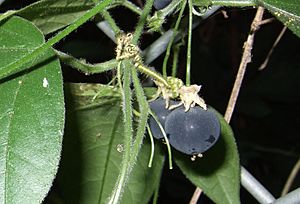Corkystem passionflower facts for kids
Quick facts for kids Corkystem passionflower |
|
|---|---|
 |
|
| Flower | |
 |
|
| Scientific classification | |
| Genus: |
Passiflora
|
| Species: |
suberosa
|
| Synonyms | |
|
Passiflora pallida L. |
|
Passiflora suberosa is a type of passionflower. It is often called the corkystem passionflower because its older stems feel like cork. This plant is found naturally in many parts of the Americas. You can find it from Florida and the Rio Grande Valley of Texas in the United States, all the way south through Mexico, Central America, and the Caribbean, down to South America.
Contents
About the Corkystem Passionflower
The corkystem passionflower is a unique plant known for its interesting stems. As the plant gets older, its stems develop a rough, cork-like texture. This is how it got its common name.
Where it Grows
This passionflower grows in many warm places. Its natural home stretches across a huge area. You can find it in the southern parts of the United States, like Florida and Texas. It also grows throughout Mexico, Central America, and the islands of the Caribbean. From there, its range continues into South America.
Its Fruit
The fruit of the corkystem passionflower changes color as it ripens. When it is young, it is green. As it gets ready to eat, it turns indigo, then purple, and finally black. This fruit is not very strong and does not do well in cold weather.
Home for Butterflies
This plant is very important for many types of butterflies. It acts as a "host plant" for their caterpillars. This means the caterpillars eat the leaves of the Passiflora suberosa to grow. It provides them with food and a safe place to live.
Some of the butterflies that use this plant are:
- The Gulf fritillary (Agraulis vanillae)
- The Julia heliconian (Dryas iulia)
- The Mexican silverspot (Dione moneta)
- The red postman (Heliconius erato)
- The zebra heliconian (Heliconius charithonia)
In Australia, it is also a host plant for the glasswing butterfly (Acraea andromacha).
Images for kids
See also
 In Spanish: Passiflora suberosa para niños
In Spanish: Passiflora suberosa para niños




